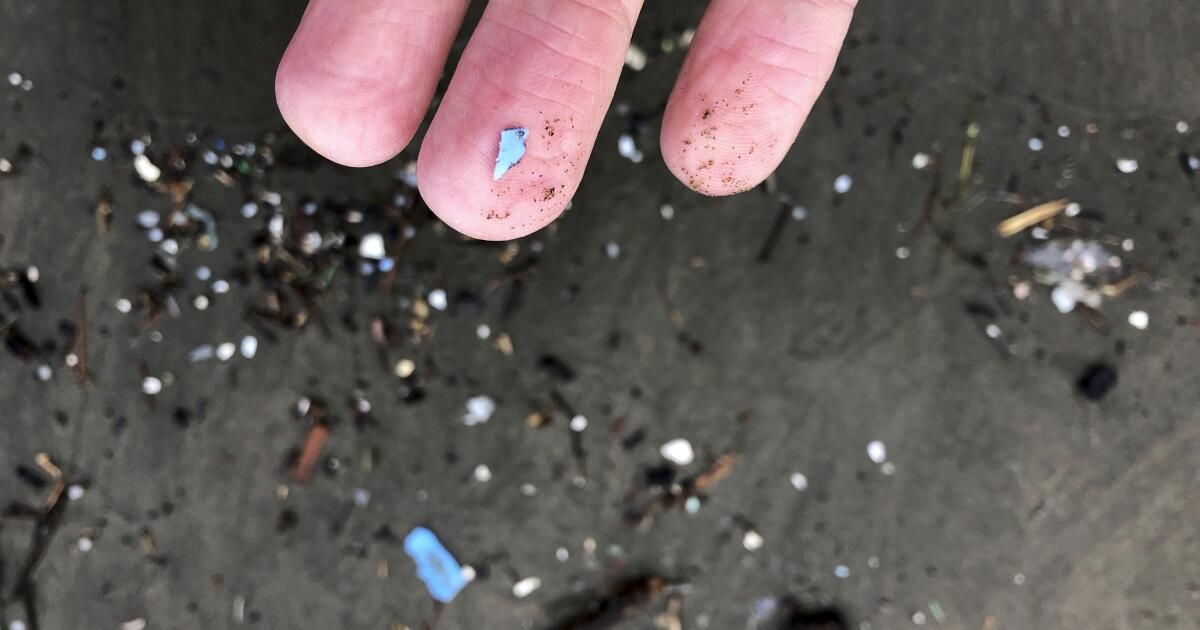Add one more possible culprit to the long list of known cardiovascular risk factors, including red meat, butter, smoking and stress: microplastics.
In a study published Wednesday in the New England Journal of Medicine, an international team of doctors and researchers showed that surgical patients who had a buildup of micro- and nanoplastics in their arterial plaque had a 2.1 times greater risk of suffering a stroke. non-fatal cardiac stroke or death from any cause within three years after surgery than those who did not have surgery.
It is the first study to show that these ubiquitous and pernicious fossil fuel-based particles are having a direct effect on human health, said study co-author Antonio Ceriello, head of the diabetes department at IRCCS MultiMedica, a research hospital in Milan. .
And it should serve as a warning to all people, governments and corporations that plastic is not only a nuisance and a plague on the environment, but also harms human health, he said.
As government officials, negotiators, environmental activists and corporate representatives prepare to meet next month in Ottawa to discuss a global ban on plastic pollution, many hope this study will help tip the balance toward establishing real, tangible regulations.
“This is a start… where people will see that plastic is not only harmful to whales or sea turtles. This is not just trash on a beach in some far away country. It's in them and it has the potential to cause harm. I think it's going to change the narrative,” said Dr. Philip Landrigan, director of the Program for Global Public Health and the Common Good at Boston College.
He compared awareness of the plastic crisis to climate change, where people understood it in an abstract and theoretical way until wildfires burned their homes, sustained heat waves wiped out their crops, and floods destroyed their communities. .
“To my knowledge, this is the first report linking microplastics to human diseases,” said Landrigan, who was not involved in the study but wrote an accompanying essay urging the global community to comply with a “mandatory global limit on plastic production”.
Matt Seaholm, president and CEO of the Plastics Industry Association, suggested more research is needed.
“We encourage legislators to evaluate where these particles come from before using any type of microplastic or nanoplastic arguments for the justification or approval of any law, because every study has shown that they do not come from packaging or single-use items,” said. .
Studies have shown that the two largest contributors of microplastics to the environment are car tires and synthetic clothing. However, as the plastics industry expands and the number of single-use plastic items grows, so does their contribution to pollution and environmental pollution. Around 151 million tons of single-use plastics were produced
of fossil fuels in 2021. That figure is expected to increase by another 19 million tons by 2027.
The arterial plaque research was conducted by a team of 40 scientists, including surgeons, engineers, statisticians and pathologists, from more than a dozen institutions, including Harvard Medical School, Brigham and Women's Hospital in Boston and Case Western Reserve School of Medicine in Cleveland. .
All 257 patients who completed the study had asymptomatic extracranial high-grade internal carotid artery stenosis; In other words, his carotid arteries were blocked with plaque. The patients underwent carotid endarterectomies, a procedure in which the artery is opened and plaque is removed. Patients who had previous heart failure, valvular defects, cancer or other causes of hypertension were disqualified.
The researchers then examined the plaque and found polyethylene micro- and nanoparticles in 150 of the patients. Thirty patients had polyvinyl chloride particles in the plaque. Electron microscopy images showed visible, irregularly edged “foreign bodies” along with biological plaque in these patients.
Polyethylene, or PET, is the plastic used to make soft drink and water bottles. Polyvinyl chloride, or PVC, is the plastic used in water pipes, packaging, medical devices, toothbrushes, children's toys, and window frames, to name a few.
The two patient populations were approximately equal in terms of age, sex, weight, smoking status, geographic location, blood pressure, and heart rate.
The only obvious difference, the authors noted, was the susceptibility of the two groups to heart disease in the months after surgery, an indication that the presence of microplastics may have played a role. In fact, inflammation indicators were higher in the group exposed to plastic. Non-fatal heart attacks, non-fatal strokes or death from any cause occurred in eight of the 107 patients who did not have microplastics in their plaque and in 30 of the 150 patients with microplastics.
The authors emphasized that they could only show correlation, not causation. Additional research would be necessary to establish a clear connection.
Study co-author Leonardo Trasande, a pediatrician and public policy expert at New York University's Grossman School of Medicine and Wagner School of Public Service, said it was equally possible that chemicals that accumulate in particles, such as bisphenol A, phthalates and/or other plasticizers and additives, could be the culprit. The article also notes that laboratory contamination and patient behaviors that the researchers are unaware of could also influence their results.
“I can't tell you what microplastics are and I can't tell you what chemicals are. “I couldn’t tell you because no study has measured both and they both coexist,” she said. “The fact is that plastics are horrible for human health and expensive.”
He pointed to a recent study he authored that showed the disease burden from these chemicals costs the U.S. healthcare system approximately $250 billion a year.
Ceriello and his co-authors looked at dozens of animal studies that showed harmful effects of microplastics. He also said the authors were still unclear how the patients were exposed, whether through inhalation or ingestion.
Recent studies have found micro- and nanoplastics in plastic bottled water, as well as in powder.
“This is very strong and should be taken very seriously at the highest level of government,” said Judith Enck, director of Beyond Plastics and former regional director of the U.S. Environmental Protection Agency. “This is consistent with other studies that have found microplastics in various organs, human blood, placenta and breast milk, so this is not that surprising, but it is surprising.”
Plastic has been found everywhere scientists have looked: from the deepest ocean trenches to the highest alpine peaks. Petroleum-based plastics do not biodegrade. Over time, they break down into smaller and smaller pieces (known as microplastics, microfibers, and nanoplastics) and have been found in household dust, drinking water, and human tissues and blood.
“Cardiologists need to tell their patients to avoid plastic packaging, which is very difficult to do,” Enck said.
Tracey Woodruff, director of UC San Francisco's Reproductive Health and Environment Program in the Department of Obstetrics, Gynecology and Reproductive Sciences, said doctors and clinicians should start talking to their patients about the harms of plastic. She authored a paper analyzing the harmful effects of endocrine disruptors in the same edition as the heart study.
He said doctors' advice to eat organic, unprocessed foods already reduces exposure to plastics. But more is needed, especially in the medical fields of reproduction, obstetrics and pediatrics, he said, where the evidence of harm from plastic chemicals and endocrine disruptors is well established.
The mounting evidence, he said, is becoming “difficult to ignore.”












